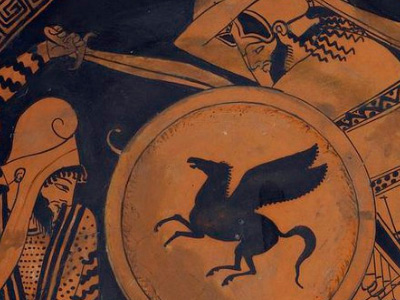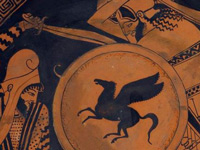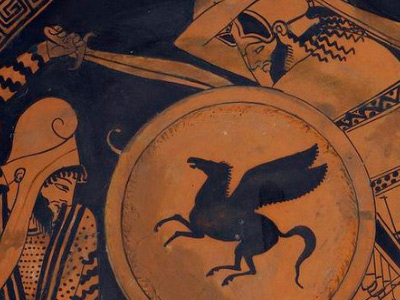Battle of Plataea (479 BC)

Prelude
When Mardonius learned of the Spartan force, he completed the destruction of Athens, tearing down whatever was left standing. He then retreated towards Thebes, hoping to lure the Greek army into territory that would be suitable for the Persian cavalry. Mardonius created a fortified encampment on the north bank of the Asopus river in Boeotia covering the ground from Erythrae past Hysiae and up to the lands of Plataea.
The Athenians sent 8,000 hoplites, led by Aristides, along with 600 Plataean exiles to join the Allied army. The army then marched in Boeotia across the passes of Mount Cithaeron, arriving near Plataea, and above the Persian position on the Asopus. Under the guidance of the commanding general, Pausanias, the Greeks took up position opposite the Persian lines but remained on high ground. Knowing that he had little hope of successfully attacking the Greek positions, Mardonius sought to either sow dissension among the Allies or lure them down into the plain. Plutarch reports that a conspiracy was discovered among some prominent Athenians, who were planning to betray the Allied cause; although this account is not universally accepted, it may indicate Mardonius' attempts of intrigue within the Greek ranks.
Mardonius also initiated hit-and-run cavalry attacks against the Greek lines, possibly trying to lure the Greeks down to the plain in pursuit. Although having some initial success, this strategy backfired when the Persian cavalry commander Masistius was killed; with his death, the cavalry retreated.
Their morale boosted by this small victory, the Greeks moved forward, still remaining on higher ground, to a new position more suited for encampment and better watered. The Spartans and Tegeans were on a ridge to the right of the line, the Athenians on a hillock on the left and the other contingents on the slightly lower ground between. In response, Mardonius brought his men up to the Asopus and arrayed them for battle; However, neither the Persians nor the Greeks would attack; Herodotus claims this is because both sides received bad omens during sacrificial rituals. The armies thus stayed camped in their locations for eight days, during which new Greek troops arrived. Mardonius then sought to break the stalemate by sending his cavalry to attack the passes of Mount Cithaeron; this raid resulted in the capture of a convoy of provisions intended for the Greeks. Two more days passed, during which time the supply lines of the Greeks continued to be menaced. Mardonius then launched another cavalry raid on the Greek lines, which succeeded in blocking the Gargaphian Spring, which had been the only source of water for the Greek army (they could not use the Asopus due to the threat posed by Persian archers). Coupled with the lack of food, the restriction of the water supply made the Greek position untenable, so they decided to retreat to a position in front of Plataea, from where they could guard the passes and have access to fresh water. To prevent the Persian cavalry from attacking during the retreat, it was to be performed that night.
However, the retreat went awry. The Allied contingents in the centre missed their appointed position and ended up scattered in front of Plataea itself. The Athenians, Tegeans and Spartans, who had been guarding the rear of the retreat, had not even begun to retreat by daybreak. A single Spartan division was thus left on the ridge to guard the rear, while the Spartans and Tegeans retreated uphill; Pausanias also instructed the Athenians to begin the retreat and if possible join up with the Spartans. However, the Athenians at first retreated directly towards Plataea, and thus the Allied battle line remained fragmented as the Persian camp began to stir.
HISTORY

RESOURCES
This article uses material from the Wikipedia article "Battle of Plataea (479 BC)", which is released under the Creative Commons Attribution-Share-Alike License 3.0.
© Stories Preschool. All Rights Reserved.









